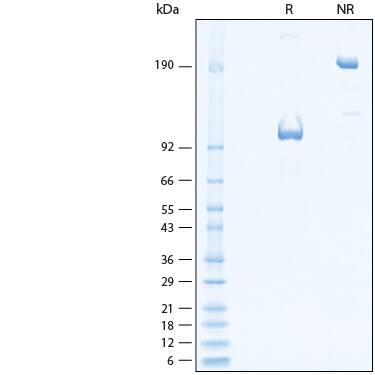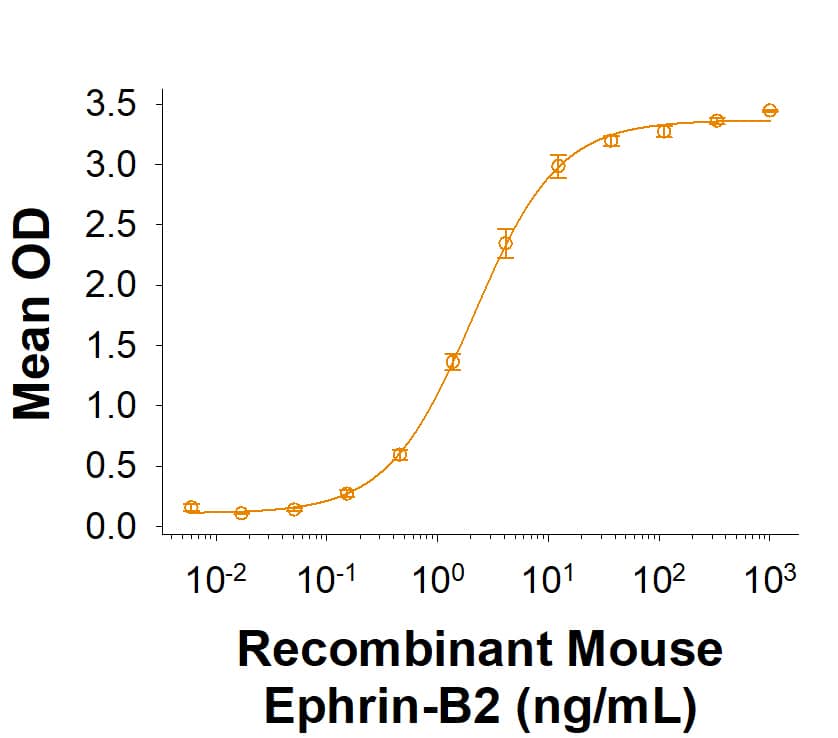Recombinant Human EphB4 Fc Chimera Protein, CF
R&D Systems, part of Bio-Techne | Catalog # 11307-B4

Key Product Details
Source
Accession #
Structure / Form
Conjugate
Applications
Product Specifications
Source
| Human EphB4 (Leu16-Arg539) Accession # AAH52804.1 |
IEGRMD | Human IgG1 (Pro100-Lys330) |
| N-terminus | C-terminus |
Purity
Endotoxin Level
N-terminal Sequence Analysis
Predicted Molecular Mass
SDS-PAGE
Activity
When Recombinant Human EphB4 Fc Chimera (Catalog # 11307-B4) is immobilized at 0.3 µg/mL (100 µL/well), Recombinant Mouse Ephrin-B2 Fc Chimera (Catalog # 496-EB) binds with an ED50 of 0.600-7.20 ng/mL.
Scientific Data Images for Recombinant Human EphB4 Fc Chimera Protein, CF
Recombinant Human EphB4 Fc Chimera Protein Binding Activity.
When Recombinant Human EphB4 Fc Chimera Protein (Catalog # 11307-B4) is immobilized at 0.3 µg/mL (100 µL/well), Recombinant Mouse Ephrin-B2 Fc Chimera Protein (496-EB) binds with an ED50 of 0.600-7.20 ng/mL.Recombinant Human EphB4 Fc Chimera Protein SDS-PAGE.
2 μg/lane of Recombinant Human EphB4 Fc Chimera Protein (Catalog # 11307-B4) was resolved with SDS-PAGE under reducing (R) and non-reducing (NR) conditions and visualized by Coomassie® Blue staining, showing bands at 95-108 kDa and 190-220 kDa, respectively.Formulation, Preparation and Storage
11307-B4
| Formulation | Lyophilized from a 0.2 μm filtered solution in PBS with Trehalose. |
| Reconstitution | Reconstitute at 500 μg/mL in PBS. |
| Shipping | The product is shipped at ambient temperature. Upon receipt, store it immediately at the temperature recommended below. |
| Stability & Storage | Use a manual defrost freezer and avoid repeated freeze-thaw cycles.
|
Background: EphB4
EphB4, also known as Htk, Myk1, Tyro11, and Mdk2, is a member of the Eph receptor tyrosine kinase family and binds Ephrin-B2. The A and B class Eph proteins have a common structural organization (1 - 4). The human EphB4 cDNA encodes a 987 amino acid precursor that includes a 15 amino acid (aa) signal sequence, a 524 aa extracellular domain (ECD), a 21 aa transmembrane segment, and a 427 aa cytoplasmic domain (5). The ECD contains an N-terminal globular domain, a cysteine-rich domain, and two fibronectin type III domains. The cytoplasmic domain contains a juxtamembrane motif with two tyrosine residues which are the major autophosphorylation sites, a kinase domain, and a conserved sterile alpha motif (SAM) (5). Activation of kinase activity occurs after membrane-bound or clustered ligand recognition and binding. The ECD of human EphB4 shares 89% aa sequence identity with mouse EphB4 and 42 - 45% aa sequence identity with human EphB1, 2, and 3. EphB4 is expressed preferentially on venous endothelial cells (EC) and inhibits cell-cell adhesion, chemotaxis, and angiogenesis. Opposing effects are induced by signaling through Ephrin-B2 expressed on arterial EC: adhesion, endothelial cell migration, and vessel sprouting (6). EphB4 singaling contributes to new vascularization by guiding venous EC away from Ephrin-B2 expressing EC. Ephrin-B2 signaling induces arterial EC to migrate towards nascent EphB4 expressing vessels (6). The combination of forward signaling through EphB4 and reverse signaling through Ephrin-B2 promotes in vivo mammary tumor growth and tumor-associated angiogenesis (7). EphB4 promotes the differentiation of megakaryocytic and erythroid progenitors but not granulocytic or monocytic progenitors (8, 9).
References
- Poliakov, A. et al. (2004) Dev. Cell 7:465.
- Surawska, H. et al. (2004) Cytokine Growth Factor Rev. 15:419.
- Pasquale, E.B. (2005) Nat. Rev. Mol. Cell Biol. 6:462.
- Davy, A. and P. Soriano (2005) Dev. Dyn. 232:1.
- Bennett, B.D. et al. (1994) J. Biol. Chem. 269:14211.
- Fuller, T. et al. (2003) J. Cell Sci. 116:2461.
- Noren, N.K. et al. (2004) Proc. Natl. Acad. Sci. 101:5583.
- Wang, Z. et al. (2002) Blood 99:2740.
- Inada, T. et al. (1997) Blood 89:2757.
Long Name
Alternate Names
Gene Symbol
UniProt
Additional EphB4 Products
Product Documents for Recombinant Human EphB4 Fc Chimera Protein, CF
Product Specific Notices for Recombinant Human EphB4 Fc Chimera Protein, CF
For research use only

